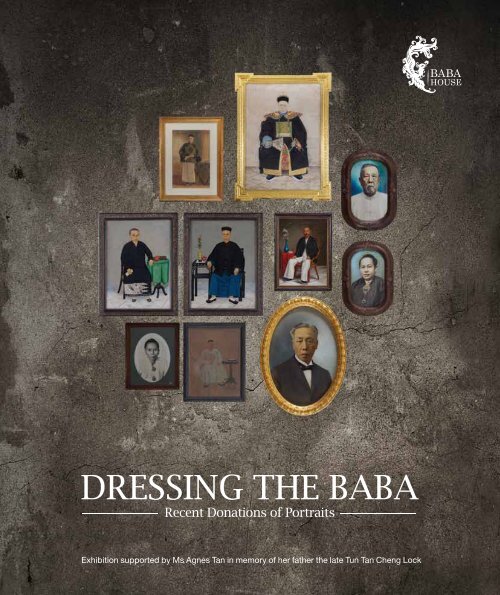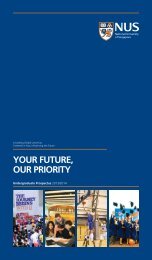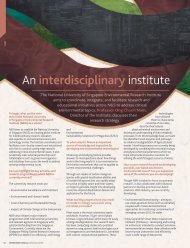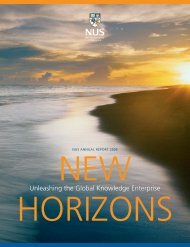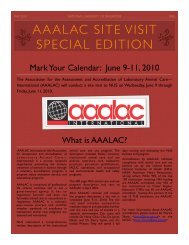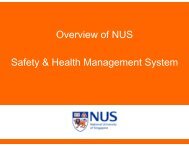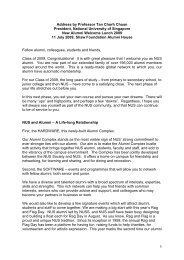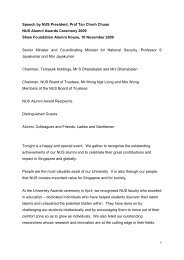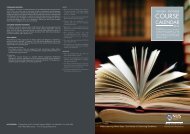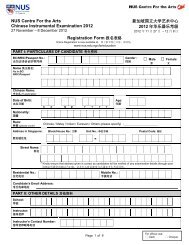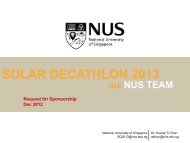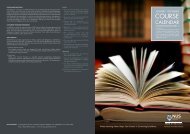Exhibition brochure - NUS - Home
Exhibition brochure - NUS - Home
Exhibition brochure - NUS - Home
You also want an ePaper? Increase the reach of your titles
YUMPU automatically turns print PDFs into web optimized ePapers that Google loves.
<strong>Exhibition</strong> supported by Ms Agnes Tan in memory of her father the late Tun Tan Cheng Lock
Published on the occasion of the exhibition<br />
Official opening 5 December 2012<br />
Acknowledgements<br />
Mr Peter Lee for the loan of artefacts<br />
Ms Sharron Chee Guek Kee for the loan of portraits from the collection of her late father Chee Teng Kwee<br />
Curation<br />
Collections and Logistics<br />
Conservation<br />
Programmes<br />
Research and Logistics Assistance<br />
Foo Su Ling<br />
Donald-Eric Lim<br />
The Conservation Studio<br />
Poonam Lalwani<br />
Suraendhiran s/o Ramadass (intern)<br />
Published by<br />
University Cultural Centre<br />
50 Kent Ridge Crescent<br />
National University of Singapore<br />
Singapore 119279<br />
Copyright © 2012 <strong>NUS</strong> Museum<br />
All rights reserved
Foreword<br />
Ahmad Mashadi<br />
Head, <strong>NUS</strong> Museum<br />
<strong>NUS</strong> Museum and Baba House are honoured to have<br />
received donations of portraits from Ms Agnes Tan, Mr<br />
Wee Lin, Mr Winson Tan, Mr Melvin Tan, and Mr Peter<br />
Lee. Also included in the exhibition are five portraits on<br />
loan from the collection the late Mr Chee Teng Kwee.<br />
We thank his daughter Ms Sharron Chee Guek Kee for<br />
this generous gesture. The donations received from Ms<br />
Agnes Tan are especially meaningful as they mark an<br />
ongoing encouragement and support to the Baba House<br />
in developing its collection of Straits Chinese materials,<br />
including emerging areas of collection and study such as<br />
Peranakan portraits.<br />
Gathered from sources in Singapore, Malacca, Penang<br />
and Java, the portraits range from coloured photographs,<br />
ink on paper, to oils. As recent additions to the Museum’s<br />
permanent collection, these portraits are significant<br />
examples of practices that were informed by patronage,<br />
taste and pictorial conventions in periods of social and<br />
economic transformations in Southeast Asia. The diversity<br />
of their subjects, origins, medium, and technical qualities<br />
indicate the complexities of change and continuity as<br />
societies across the region at the turn of the 20th century<br />
accommodated newer expressions while sustaining<br />
aspects of older practices.<br />
Ancestral ink and oil portraits and modern studio<br />
photographs were displayed in homes according to their<br />
varied functions; to facilitate family rituals, to map ties,<br />
and to define social settings. As images that defined social<br />
and economic status, the subjects were characterized by<br />
their fineries and gestures. Beyond structured devices and<br />
formalities, these images may be studied as part of our<br />
attempts to understand the modern as a condition that<br />
requires newer forms of social, economic and cultural<br />
negotiations and expressions. This exhibition at the<br />
Baba House is conceived to celebrate the donations.<br />
However, while doing so, we also hope to prospect fresh<br />
grounds of investigations, not only germane in organizing<br />
an upcoming exhibition at the <strong>NUS</strong> Museum, but also<br />
significant in framing potentials of collections development<br />
and curatorial research.<br />
1
Preliminary Frames<br />
Fashion, Gender, Class and Modernity in<br />
<strong>NUS</strong> Museum’s Straits Chinese Portraits Collection<br />
Foo Su Ling<br />
This exhibition of portraits at Baba House presents a<br />
selection from <strong>NUS</strong> Museum’s Straits Chinese collection<br />
and foregrounds an exhibition to be held at the Museum in<br />
the latter half of 2013. The portraits are gifts from several<br />
donors; some pieces coming from the donors’ respective<br />
family collections while others were acquired and<br />
collected over a period of time. The works range in stylistic<br />
approaches and formal qualities. They are collected as<br />
examples of early practices in art making, in particular<br />
when photographic and artist studios were emerging in the<br />
late 19 th and early 20 th centuries. The collection also forms<br />
part of the growing category of Straits Chinese material<br />
culture and is indicative of the economies of art patronage<br />
and cultural projections.<br />
There are no known specialized portrait collections of the<br />
domiciled Chinese community in Southeast Asia. <strong>NUS</strong><br />
Museum’s collection of such materials is modest at this<br />
point, with research and analysis in its preliminary stages.<br />
Nonetheless, the assortment of works offers grounds for<br />
embarking on the study of portrait making in the region<br />
and its differentiate formal and thematic interests.<br />
Lim Kim Swee<br />
Ancestral Portrait of Tan Keow<br />
1898, Singapore<br />
Ink on Paper, 129 x 101 cm<br />
3
The Portraits<br />
The collection currently holds 50 portraits produced from<br />
the late 19 th to early 20 th century. Many of the works that<br />
were acquired from dealers and third parties are undated,<br />
and information on each piece remains relatively scarce<br />
and fragmented with much to be discovered. In this<br />
respect, opportunities abound for those pursuing studies<br />
on portraiture with an interest in undertaking research on<br />
the cataloguing elements of pictorial materials.<br />
The portraits may be subdivided along the following<br />
media – 13 oils on canvas or board, 8 watercolours and 29<br />
photographs. Of the photographed works, a number are<br />
painted over with gouache, a technique used to add colour<br />
and artistic touches to enhance black and white images<br />
prior to the invention of colour photography. A handful of<br />
portraits are attributable to specific artists namely, Lim Kim<br />
Swee; Low Kway Song; Luo Yihu; Ong Swee Hong; and the<br />
photographic studios of G.R. Lambert, Gustave Moglei and<br />
T. Williamson. Three of the watercolour portraits (Ancestral<br />
Portrait of Tan Keow, Ancestral Portrait of Wee Boon Teck<br />
and Portrait of Tan Beng Wan) representing members from<br />
two different families were painted by Lim Kim Swee.<br />
Portrait of Tan Kim Seng by Luo Yihu has a composition<br />
comparable to two other paintings, one belonging to the<br />
National Heritage Board and the other located at the Tan<br />
Kim Seng ancestral home in Malacca. This assembly of<br />
signed works is significant as primary sources for further<br />
survey on artistic practices and studio processes.<br />
The portraits originate from British Malaya as well as the<br />
Dutch East Indies and it has been possible to establish<br />
the provenance of each work back to the point of the<br />
item coming into the possession of the respective donor.<br />
More groundwork would be necessary to locate the earlier<br />
histories of each piece; such knowledge would form the<br />
basis for constructing a fascinating account of how this<br />
category of collectibles travels through family homes<br />
across generations, or circulate in the collecting market.<br />
Luo Yihu<br />
Portrait of Tan Kim Seng<br />
c. 1860, Singapore<br />
Oil on Canvas, 97 x 76 cm<br />
The majority of the subjects represented in the collection are<br />
of ethnic Chinese descent and the identities of about half<br />
are known. Among the unidentified sitters, it is possible to<br />
recognize those from Peranakan Chinese 1 families through<br />
the costume of the ladies, namely the baju panjang (Portrait<br />
of a Man in Blue Mandarin Robe and Lady in Black Baju<br />
Panjang and Yellow-Orange Sarong with Brown Designs<br />
is an example). In circumstances where the female half of<br />
the couple is attired in Chinese-style garment (as in the<br />
pair made up of Portrait of a Lady in Green Chinese-Style<br />
Blouse and Skirt, and Portrait of a Gentleman in Black<br />
Mandarin-Collared Jacket and White Trousers) or when<br />
portraits do not come in a set and only a man is featured,<br />
it is less certain if the subjects were from families with a<br />
1 Peranakan Chinese refers to the domiciled ethnic Chinese community in Southeast Asia. The term ‘Straits Chinese’ is also used in this<br />
essay when referring to Peranakan Chinese residing in Malaya, particularly in the Straits Settlements (the ‘Straits’).<br />
4
Unsigned<br />
Portrait of a Man in Blue Mandarin<br />
Robe and Lady in Black Baju Panjang<br />
and Yellow-Orange Sarong with Brown<br />
Designs<br />
c. 1890, Indonesia<br />
Oil on Canvas, 54 x 39 cm<br />
Unsigned<br />
Portrait of a Lady in Green<br />
Chinese-Style Blouse and Skirt<br />
c. 1900, Indonesia<br />
Oil on Canvas, 92.3 x 58.7 cm<br />
Unsigned<br />
Portrait of a Gentleman in Black<br />
Mandarin-Collared Jacket and White<br />
Trousers<br />
c. 1900, Indonesia<br />
Oil on Canvas, 92.3 x 58.7 cm<br />
history of residency Southeast Asia or new immigrants<br />
to the region. Accompanying the selection depicting<br />
individuals and couples are a few group portraits where the<br />
sitters are affiliated through their participation in various<br />
organizations or attendance at momentous occasions<br />
(Group Photo at 13 Amber Road and Group Photo at 17<br />
Paya Lane). The subjects’ outfits and adornments, their<br />
expressions, postures, and the objects surrounding them,<br />
work collectively towards projecting particular identities<br />
which offer numerous standpoints from which to explore<br />
concepts, ideas and functions in portrait making.<br />
Unsigned<br />
Group Photo at 13 Amber Road<br />
c. 1920, Singapore, Photograph, 24 x 29 cm<br />
5
Dress and Distinction<br />
Referencing the collection, it is noticeable that at the turn<br />
of the 20 th century, a change occurred in the costume<br />
choices of male subjects; from the traditional Chinese long<br />
gown, the Western suit or a hybrid of Chinese and Western<br />
fashion became the norm. The vestimentary code for ladies,<br />
however, appears to have remained consistent with sitters<br />
continuing the tradition of presenting themselves in the baju<br />
panjang. Portraits furnish a wealth of details for the scrutiny<br />
of dress and dressing, a trajectory which is explored in<br />
the rest of this essay. Dress is studied in relation to the<br />
wider political climate and social conventions surrounding<br />
gender, status and outlook, and attempts are made to<br />
apprehend the connections between the (un)changing<br />
direction of fashion and the transformations society was<br />
undergoing during the era.<br />
In the portraits that are chronologically earlier, the long<br />
gown appears to have been the preferred apparel for male<br />
subjects. Tan Beng Swee’s attire (Portrait of Tan Beng<br />
Swee) is a one-piece body-length gown. Both Tan Jiak<br />
Kim (Photo of Tan Jiak Kim) and the subject in Portrait of<br />
a Man in Black Chinese Jacket and Blue Gown combine<br />
the Manchu-style jacket with a waist to ankle length gown.<br />
The jacket, which may be waist length or could extend to<br />
cover the abdomen, sports a rounded tip mandarin collar<br />
and is fastened down the front with Chinese knot and loop<br />
buttons. All three subjects use white socks and footwear of<br />
dark coloured fabric with white soles.<br />
Over various historical periods, elite classes from different<br />
cultures have shown a predisposition towards fashion<br />
encompassing flowing drapery not only for females but<br />
also among males. Up until the 20 th century, the sarong –<br />
a single length of cloth wrapped around the lower half of<br />
the body – was a familiar male apparel in Southeast Asia<br />
across social strata, with class distinction evident mainly<br />
in the type of fabric used and motifs imprinted on the<br />
material. In present times, this continues to be a mode of<br />
dressing for men at rituals, ceremonies and celebrations<br />
held in observance of traditions.<br />
Unsigned<br />
Portrait of Tan Beng Swee<br />
c. 1880, Singapore<br />
Watercolour on Paper, 59 x 42.5 cm<br />
Traditional Chinese society deemed the long gown worn<br />
over trousers to be attire befitting men of stature – the<br />
gentry, literati, public officials and wealthy merchants. As<br />
recent as the 1930s, Chinese writer Lin Yutang opined<br />
that the human body, being essentially similar to that of<br />
a monkey, was best served by clothes which concealed<br />
rather than accentuate bodily forms (Harrist 2005: 175,<br />
citing Lin Yutang). This sartorial principle is reflected<br />
in the loose-fitting apparel on Tan Beng Swee and Tan<br />
Jiak Kim, but is most evident in the official robes of the<br />
Qing court exemplified in the ancestral portraits of Wee<br />
Boon Teck and Tan Beng Wan (Ancestral Portrait of Wee<br />
6
G R Lambert<br />
Photo Portrait of Tan Jiak Kim<br />
c. 1900, Singapore<br />
Photograph, 71.8 x 46.6 cm<br />
Unsigned<br />
Portrait of a Man in Black<br />
Chinese Jacket and Blue Gown<br />
c. 1890, Indonesia<br />
Oil on Canvas, 58 x 42.5 cm<br />
Lim Kim Swee<br />
Ancestral Portrait of Wee Boon<br />
Teck<br />
c. 1888, Singapore<br />
Ink on Paper, 114.5 x 83.5 cm<br />
Lim Kim Swee<br />
Portrait of Tan Beng Wan<br />
1896, Singapore<br />
Watercolor, Gouache and<br />
Gilding on Paper, 98.5 x 72 cm<br />
Boon Teck and Portrait of Tan Beng Wan). The massive<br />
gowns of these gentlemen, replete with elaborate and<br />
colourful insignia and motifs, draw attention away from<br />
all bodily articulations except the head, hands and shod<br />
feet. Not unlike the Romans who saw trousers as articles<br />
of clothing for nomadic barbarians and peasants (Steele<br />
1989: 14), the Chinese regarded this bifurcated design as<br />
an undergarment and its exposure in public suggested a<br />
wearer of proletarian origins (Harrist 2005: 176).<br />
The port cities of Southeast Asia witnessed vast immigration<br />
of Chinese from the 19 th to early 20 th centuries. By this time,<br />
the Straits Chinese were already a distinct community with<br />
a relatively long history of residence in the region. Men<br />
from these families actively establish themselves in the<br />
frameworks of formal and informal authority governing<br />
the community of local-born Chinese and the growing<br />
immigrant population from China. In their official capacities<br />
as Kapitans, municipal commissioners and Justice of<br />
Peace, the Babas assisted the colonial office in mediating<br />
disputes and maintaining order. As owners of successful<br />
commercial enterprises, they were employers and also<br />
patrons of schools, hospitals and welfare groups.<br />
Temples were prominent social and cultural spaces for<br />
the Chinese community. Setting foot on the shores of<br />
Nanyang for the first time, the preliminary encounters of<br />
new Chinese arrivals with local society took place at these<br />
sites of worship where they offered thanks to the deities<br />
for safe passage and relied on the temple infrastructure<br />
for advice, job references and welfare. With the immigrant<br />
population comprising mainly single males, these spaces<br />
also served as focal points for socializing, entertainment<br />
and the practice of cultural traditions and celebrations.<br />
The Babas participated actively in the ‘public displays<br />
and structures of informal government centred within and<br />
around [the temples]’ (Frost 2005: 9). While leadership and<br />
acts of patronage consolidated their relationship with and<br />
influence over the newcomers, the long gowns in which<br />
the Babas were sported, both in person and on images,<br />
offered a form of everyday visual messaging, continuously<br />
reinforcing the status and position of these gentlemen to<br />
an audience familiar with the Chinese sartorial language of<br />
the time.<br />
7
The Politics of Dress<br />
Among the male subjects sitting for portraits at the turn<br />
of the 20 th century, a shift in choice of outfit is observed<br />
with the Chinese gown and jacket giving way to sharply<br />
cut Western suits. A variety of styles were adopted – Wee<br />
Eng Cheng (Photo Portrait of Wee Eng Cheng) uses a<br />
two-piece suit with a waistcoat in contrasting fabric; the<br />
subject in Portrait of a Man in Greenish-Grey Three Piece<br />
Suit with Orchid on Lapel favours the more formal three<br />
piece variation; and the winged collar and bow tie suggest<br />
that Chee Tye Cheng (Photo Portrait of Chee Tye Cheng) is<br />
in a formal dinner apparel. What can be inferred from this<br />
change in fashion?<br />
Inroads made by European trading companies introduced<br />
Western fashion to East and Southeast Asia. In colonized<br />
Southeast Asia, the ubiquitous outfit of European<br />
administrators – the men’s suit – became a common sight<br />
and by association with its wearers, evolved into a marker<br />
of status and rule. Electing to present oneself in a suit<br />
signified participation, or legitimacy to participate, in the<br />
new colonial order.<br />
Taylor and Van Djik situate the adoption of the Western<br />
suit by Javanese males in relation to presence in the Dutch<br />
political sphere. Widespread use of the suit occurred in<br />
the 19 th century when the Javanese middle-classes were<br />
co-opted to run the colonial state. When first used by the<br />
administrative officers, teachers, soldiers and policemen,<br />
the costume represented delegated authority held by<br />
Javanese men working in the service of the Dutch. Over<br />
time, it became the uniform of the nationalists, ‘men<br />
who wanted to push both the Dutch rulers and Java’s<br />
aristocracy aside’ (Taylor 1997: 100-101) and proclaim their<br />
own legitimacy to lead the nation.<br />
Scientific discoveries and technological innovations in 19th<br />
century Europe propelled the emergence of nations seen<br />
to be progressive in ideology and practices covering every<br />
aspect of public and private life – public administration,<br />
commercial cultivation, education, medicine, hygiene<br />
and decorum. European expansion introduced Western<br />
Unsigned<br />
Photo Portrait of Wee Eng Cheng<br />
c. 1920, Singapore<br />
Photograph, 20 x 15 cm<br />
notions of modernity to urban centres across the globe<br />
and developing ‘progressive’, ‘enlightened’ and ‘civilized’<br />
states was soon viewed not only as a productive but also<br />
an inevitable endeavour.<br />
The full force of such ‘civilizing mission’ was felt in<br />
colonized centres, but nations which managed to avoid<br />
direct colonial rule – Thailand and the treaty ports of East<br />
Asia – felt equally compelled to undertake self-reforms,<br />
including transformations in outward appearances. In<br />
Thailand, Western-style uniform became a forceful symbol<br />
of modernization with the aristocracy leading the way in<br />
restyling the royal dress along Western lines. King Mongkut<br />
(Rama IV) and his successors adopted the Western military<br />
uniform and harnessed the power of photographed and<br />
painted images to fashion Thai royalty as an institution<br />
8
Low Kway Song<br />
Portrait of a Man in Greenish-Grey<br />
Three Piece Suit with Orchid on Lapel<br />
1917, Malaysia (Penang)<br />
Oil on Board, 49 x 33 cm<br />
T Williamson<br />
Photo Portrait of Chee Tye Cheng<br />
c. 1910, Malaysia (Malacca)<br />
Gouache on Photograph, 49 x 34 cm<br />
fostering progressive ideas (Peleggi 2007: 68-69). Here,<br />
Western-style dress emerges as an embodiment of<br />
modernity, embracing this fashion suggests competency<br />
in the values and concepts associated with it, and the<br />
inferred right to political freedom and self-rule.<br />
Politics of dress aside, an additional perspective may be<br />
applied in understanding the Straits Chinese community’s<br />
transition to Western fashion – the pride in being British<br />
subjects. English education and commitment to British rule<br />
are among the factors Chua (2010: 136-138) highlights as<br />
common characteristics defining the identity of the multiethnic<br />
domiciled communities in Malaya. Preferred use of<br />
the English language in the home, the honour felt in being<br />
‘King’s (Queen’s) Chinese’ and enthusiastic support of the<br />
crown are evidences of the Baba’s amicability towards the<br />
British; embracing British culture including forms of dress<br />
was consistent with this affinity.<br />
The language of fashion is fluid and while it adjusts in<br />
response to the political landscape, it is equally pliable in<br />
accommodating personal tastes and inclinations. Attempts<br />
by local communities to negotiate their ethnic identities<br />
in a climate of foreign sovereignty saw the combining of<br />
elements from different modes of dress, giving rise to<br />
fascinating hybrid styles. In his ancestral portrait, Wee<br />
Boon Teck is seen in the voluminous Qing official robe, but<br />
his daily wear appears to have been the Chinese top with<br />
baggy trousers (Photo Portrait of Wee Boon Teck). Wee’s<br />
headgear is a western Homburg typified by a rift down the<br />
centre of the hat and he uses a pair of pumps, a low-heel<br />
leather shoe which was not an uncommon facet of formal<br />
9
Unsigned<br />
Photo Portrait of Wee Boon Teck<br />
c. 1880, Singapore<br />
Graphite on Paper, 66.5 x 44 cm<br />
Unsigned<br />
Portrait of a Man in Black Jacket with Red Buttons<br />
c. 1890, Indonesia<br />
Oil on Canvas, 51 x 38.5 cm<br />
European male attire. The subject in Portrait of a Man in<br />
Black Jacket with Red Button dons a contemporary jacket<br />
over a collarless shirt with Chinese knot and loop buttons.<br />
Two Malay gentlemen in Group Photo at 17 Paya Lane<br />
combine the sarong with a western jacket. One uses the<br />
songkok, a traditional Malay headdress, while the other<br />
projects his religious affiliation with the skullcap. Haji<br />
Manjoor Sahib Maricar, the person for whom the gathering<br />
was held, is in a full Western suit but uses the songkok as<br />
a marker of his ethnic identity. Taylor (1997: 97-98) noted<br />
similar adaptations among Javanese officials in the Dutch<br />
colonial service. The men assigned clothing styles from<br />
distinct fashion regimes to different parts of the body –<br />
stiff-necked shirt, bow-tie, and jacket which declared their<br />
official place in the Dutch administration, and the batik<br />
kain on the lower half of their body proclaiming privileged<br />
descent.<br />
Unsigned<br />
Group Photo at 17 Paya Lane<br />
c. 1920, Singapore<br />
Photograph, 24 x 29 cm<br />
10
Traditional Female Dress and its Representations<br />
Imageries of ladies in traditional costume alongside their<br />
menfolk in Western suit have been read in relation to the<br />
subordinate position of the former and their limited access<br />
to modernity. Commenting on images of Indonesian men<br />
and women on public stages, Taylor (1997: 113) observes<br />
that ‘the camera creates associations of male gender<br />
with public power by showing men in suits. The camera<br />
associates female gender with distance from modernity<br />
by showing women in forms of ‘native’ wear. Natives and<br />
women become equated as subordinates.’<br />
Alwis’ (1999) research on colonial Ceylon reveals active<br />
criticisms in the Singhala press about women’s adoption<br />
of Western outfits. Their ‘respectability’ was deemed to<br />
have been destroyed by ‘short, sleeveless jackets which<br />
laid bare the arms and midriff, low cut jackets which<br />
exposed bosoms and shoulders, and jackets made out<br />
of transparent cloth that ‘exposed the entire upper half of<br />
the body’’ (Alwis 1999: 183). Sinhalese reformer Anagarika<br />
Dharmapala prescribed the saree – a six-yard long cloth<br />
draped around the body – as a proper garment for women<br />
and advocated a similar form for men. Women across<br />
the low country, including Dharmapala’s mother, heeded<br />
his call for dress reform but the response was much less<br />
enthusiastic among Sinhalese men. Alwis proposed that<br />
‘[t]his gendered response… speaks to the differential<br />
positioning of women within colonial modernity and<br />
patriarchy; there was more at stake in women signifying<br />
the purity of their ‘culture’ than for men’ (Alwis 1999: 181).<br />
Our present portrait collection offers little occasion<br />
for rebutting the arguments presented by Taylor and<br />
Alwis – alongside smartly suited Babas, the nyonyas in<br />
their traditional baju panjang (Portrait of a Lady in Black<br />
Baju Panjang with Small Printed Patterns and Checked<br />
Reddish-Brown Sarong and Photo Portrait of Mrs Chee<br />
Tye Cheng) appear to be the bastion of conservative values.<br />
Scholarships further underline the patriarchal Confucian<br />
nature of Peranakan Chinese families where pressure to<br />
maintain traditions and observe customary practices were<br />
tasks women had to undertake on behalf of their husbands’<br />
families (Seah 2005: 31-36). While this may be a deeply<br />
unfavourable prospect in today’s context, the possibility<br />
that a notable proportion of Peranakan Chinese ladies at<br />
that time found a sense of purpose in these responsibilities<br />
cannot be overlooked.<br />
A hierarchical structure defines the relationship among<br />
women in traditional domestic settings starting with the<br />
matriarch and branching downwards to the servants (Chua<br />
2004: 7). The matriarch led in matters pertaining to the<br />
household and the extended family; it was not uncommon<br />
for her to be visually ‘positioned at the apex of clan<br />
genealogies’ with her portrait hanging above the ancestral<br />
altar, a remarkable situation in the patriarchal Peranakan<br />
community (Lee 2011: 3). The day-to-day wear of the<br />
matriarch was the baju panjang, and while the Western suit<br />
associated the male gender with public power, the baju<br />
panjang connected the female gender with control in the<br />
private domain of home.<br />
The late 19 th century saw the Straits Chinese Reform<br />
Movement proposing formal schooling for girls. Education,<br />
in particular English education, was a key contributing<br />
factor to the emergence of the ‘Modern Girl’ in the early<br />
decades of the 20 th century and by the 1920s, she was<br />
a visible phenomenon in urban centres around the world<br />
(Lewis 2009: 1385-1388). Recognizable by her appearance<br />
(cropped hair, miniskirts, heels, sunglasses) and lifestyle<br />
(dance parties, sports, shopping, dating), education<br />
afforded her a presence in the public sphere by way of<br />
professional employment and expression in the press. The<br />
proposed education reforms for girls, however, enjoyed<br />
neither widespread support nor swift implementation. If at<br />
all, conservative Straits Chinese parents provided daughters<br />
with the most rudimentary formal learning opportunities for<br />
fear that too much education would reduce the chances<br />
of marriage for the girls (Seah 2005: 35, 50). Other parents<br />
were of the view that skills learnt at school would be of little<br />
consequence as the girls would eventually operate only in<br />
the domestic realm.<br />
11
Unsigned<br />
Portrait of a Lady in Black Baju Panjang with Small Printed<br />
Patterns and Checked Reddish-Brown Sarong,<br />
c. 1890, Malaysia (Penang), Oil on Canvas, 63.5 x 50.5 cm<br />
T Williamson<br />
Photo Portrait of Mrs Chee Tye Cheng<br />
c. 1910, Malaysia (Malacca),<br />
Gouache on Photograph, 49 x 34 cm<br />
Confined to an environment where traditional views towards<br />
women continued to be fostered, the role of wife and<br />
mother, and the hierarchy within the household, remained<br />
the only reality for a majority of nyonyas. The Modern<br />
Girl destabilized this established pattern. Professional<br />
employment freed her from the confines of the home while<br />
financial independence offered a degree of flexibility in<br />
lifestyle choices. Her active presence in the public sphere<br />
and her outward appearance challenged traditionally<br />
sanctioned norms of decorum. In essence, the Modern<br />
Girl heralded an era of change, injecting uncertainty into<br />
the framework of authority which privileged the matriarch<br />
and senior female members of the household. Emphasis<br />
on the observance of tradition, and reinforcing this through<br />
its manifestations – the traditional dress being an example<br />
– afforded the ladies a sense of stability in a climate of<br />
change, and a means of articulating seniority within the<br />
household.<br />
This essay provides a preliminary reading of the portraits<br />
in the Museum’s collection by reflecting on how these<br />
visual materials advance the projection of self through<br />
the adoption and appropriation of fashion. This process,<br />
whether deliberate or unconscious may be further<br />
understood in relation to the historiography of colonialism<br />
and discourse on modernity.<br />
Foo Su Ling is a curator at <strong>NUS</strong> Museum.<br />
12
Bibliography<br />
Alwis, Malathi de, ‘‘Respectability’, ‘Modernity’ and the Policing<br />
of ‘Culture’ in Colonial Ceylon’, in Antoinette Burton (ed), Gender,<br />
Sexuality and Colonial Modernities, London: Routledge, 1999,<br />
177-192.<br />
Chua Ai Lin, ‘The Domiciled Identity in Colonial Singapore:<br />
Understanding the Straits Chinese beyond Race, Nation and<br />
Empire’ in Leo Suryadinata (ed), Peranakan Chinese in a<br />
Globalizing Southeast Asia, Singapore: Chinese Heritage Centre<br />
and Baba House, 2010, 135-144.<br />
Chua Ai Lin, ‘Singapore, Colonial Cosmopolis c. 1930: The World<br />
of the Modern Girl’ (paper presented at Asia Research Institute in<br />
2004, unpublished).<br />
Finnane, Antonia, ‘What Should Chinese Women Wear?: A<br />
National Problem’ in Modern China, Vol. 22, No. 2, April 1996,<br />
99-131.<br />
Frost, Mark Ravinder, ‘Transcultural Diaspora: The Straits Chinese<br />
in Singapore, 1819-1918’ in Asia Research Institute Working<br />
Paper Series, No. 10, August 2003, Singapore: Asia Research<br />
Institute, 2003.<br />
Frost, Mark Ravinder, ‘Emporium in Imperio: Nanyang Networks<br />
and the Straits Chinese in Singapore 1819-1914’ in Journal of<br />
Southeast Asian Studies, 36(1), 29-66, February 2005, New York:<br />
Cambridge University Press.<br />
Harrist, Robert E. Jr., ‘Clothes Make the Man: Dress, Modernity,<br />
and Masculinity in China, ca. 1912-1937’ in Wu Hung and<br />
Katherine R. Tsiang (eds), Body and Face in Chinese Visual<br />
Culture, Cambridge (Massachusetts) and London: Harvard<br />
University Asia Center, 2005, 171-193.<br />
Hollander, Anne, Sex and Suits, New York: Alfred A. Knopf, 1994.<br />
Ikeya Chie, ‘The Modern Burmese Woman and the Politics of<br />
Fashion in Colonial Burma’ in The Journal of Asian Studies, Vol.<br />
67, Issue 04, November 2008, 1277-1308.<br />
I-S Magazine (online), ‘Interview: Stella Kon’ at http://is.asia-city.<br />
com/city-living/article/interview-stella-kon.<br />
Lee, Peter, ‘Good Girl, Bad Girl’ in The Peranakan, Issue 4,<br />
Singapore: The Peranakan Association Singapore, 2011, 3-5.<br />
Lewis, Su Lin, ‘Cosmopolitanism and the Modern Girl: A Cross-<br />
Cultural Discourse in 1930s Penang’ in Modern Asian Studies,<br />
Volume 43, Issue 6, Cambridge University Press, 2009, 1385-<br />
1419.<br />
Molony, Barbara, ‘Gender, Citizenship and Dress in Modernizing<br />
Japan’ in Mina Roces and Louise Edwards (eds), The Politics<br />
of Dress in Asian and the Americas, Great Britain, USA: Sussex<br />
Academic Press, 2007, 81-100.<br />
Neo, David, ‘Cherita Rumah Tangga (Tales of the Household)’ in<br />
The Peranakan, Issue 4, Singapore: The Peranakan Association<br />
Singapore, 2011, 7-9.<br />
Peleggi, Maurizio, ‘Refashioning Civilization: Dress and Bodily<br />
Practice in Thai Nation-Building’ in Mina Roces and Louise<br />
Edwards (eds), The Politics of Dress in Asian and the Americas,<br />
Great Britain, USA: Sussex Academic Press, 2007, 65-80.<br />
Seah Bee Leng, Phoenix Without Wings: The Negotiations of<br />
Modernity Among Straits Chinese Women in Early Twentieth<br />
Century Singapore, Thesis submitted for the Degree of Master<br />
of Arts, Department of History, National University of Singapore,<br />
2005.<br />
Song Ong Siang, One Hundred Years’ History of the Chinese in<br />
Singapore, Singapore: Oxford University Press, 1985 (second<br />
impression).<br />
Steele, Valerie, ‘Appearance and Identity’ in Claudia Brush<br />
Kidwell and Valerie Steele (eds), Men and Women, Dressing the<br />
Part, Washington: Smithsonian Institution Press, 1989, 6-21.<br />
Taylor, Jean Gelman, ‘Costume and Gender in Colonial Java, 1800<br />
- 1940’ in Henk Schulte Nordholt (ed.), Outward Appearances:<br />
Dressing State and Society in Indonesia, Lieden: KITLV Press,<br />
1997, 85-116.<br />
Van Dijk, Kees, ‘Sarong, Jubbah, and Trousers: Appearance as a<br />
means of distinction and discrimination’ in Henk Schulte Nordholt<br />
(ed.), Outward Appearances: Dressing State and Society in<br />
Indonesia, Lieden: KITLV Press, 1997, 39-83.<br />
Wue, Roberta, ‘Essentially Chinese: The Chinese Portrait Subject<br />
in Nineteenth-Century Photography’ in Wu Hung and Katherine<br />
R. Tsiang (eds), Body and Face in Chinese Visual Culture,<br />
Cambridge (Massachusetts) and London: Harvard University Asia<br />
Center, 2005, 257-280.<br />
13
<strong>NUS</strong> Baba House<br />
A gift from Ms Agnes Tan to the National University of Singapore, the <strong>NUS</strong> Baba House was officially opened in September 2008.<br />
Once the ancestral home of a Straits Chinese family, it is now conceived as a heritage house which facilitates appreciation,<br />
reflection and research into the Straits Chinese history and culture. This is articulated primarily through the reconstruction of a<br />
domestic space characterised by the architectural conservation of the shophouse, and restoration of interiors including furnishing,<br />
household materials and decorative features. Research, conservation and restoration were undertaken in partnership with <strong>NUS</strong><br />
Department of Architecture and Urban Redevelopment Authority.<br />
The first and second floors of the Baba House reference the community’s material culture during the first half of the 20 th century.<br />
The third floor hosts temporary exhibitions, encouraging academic researchers and art practitioners to explore fresh perspectives<br />
into an evolving discourse on the Straits Chinese, and to develop insights into cultural encounters, hybridity and their contemporary<br />
implications. Baba House is also a unique resource for the study of architectural traditions, conservation efforts and urban<br />
developments in Singapore.<br />
O utra m<br />
Outram Park<br />
E u To n g S e n S t<br />
N e w B r i d g e R d<br />
R d<br />
3<br />
157 Neil Road<br />
Singapore 088883<br />
T: (65) 6227 5731<br />
E: babahouse@nus.edu.sg<br />
www.nus.edu.sg/museum/baba<br />
Visits to the exhibition only (3rd floor) are free and By<br />
Appointment.<br />
To Singapore<br />
General Hospital<br />
1<br />
K g B a h r u<br />
B la ir R d<br />
R d<br />
H o s p ita l<br />
D r<br />
New Bridge Rd<br />
Bus Terminal<br />
2<br />
Park Rd<br />
S p o ttis w o o d e<br />
E u<br />
N e il<br />
BABA<br />
HOUSE<br />
E v e r to n<br />
T o n g S e n S t<br />
N e w B r i d g e<br />
E v e rto n<br />
4<br />
R d<br />
R d<br />
Blk 3<br />
Blk 6<br />
Police<br />
Cantonment<br />
Complex<br />
R d<br />
Blk 2<br />
Blk 7<br />
Blk 5<br />
R d E v e rto n P a r k<br />
Multi-storey<br />
Carpark<br />
C a n t o n m e n t<br />
R d<br />
N e i l<br />
R d<br />
Visits to the 1st and 2nd floors are By Appointment Only.<br />
Visitors are required to sign up in advance for a heritage<br />
tour.<br />
Parking available<br />
MRT station<br />
1<br />
2<br />
Bus services<br />
61, 124, 143, 147, 166, 167, 196, 197, 961<br />
2, 12, 54, 174, 174e, 190, CT8, CT18, CT28<br />
3 61, 124, 143, 147, 166, 197, 961<br />
4 61, 166, 167, 196, 197<br />
<strong>NUS</strong> Baba House is managed by <strong>NUS</strong> Museum, an<br />
institution of <strong>NUS</strong> Centre For the Arts<br />
www.nus.edu.sg/museum


